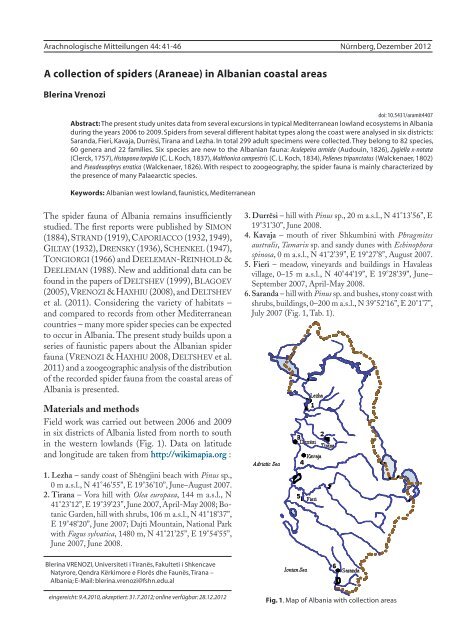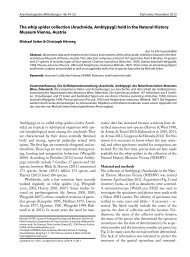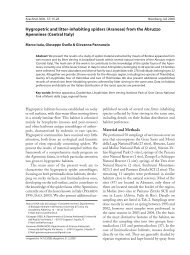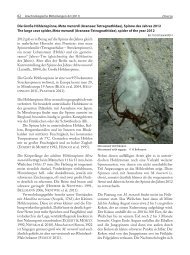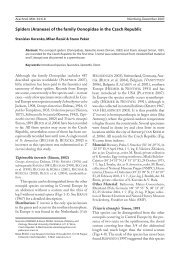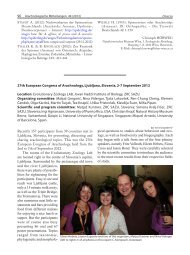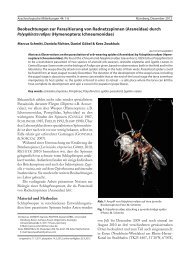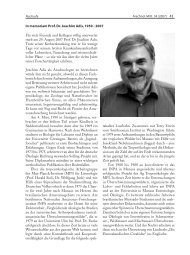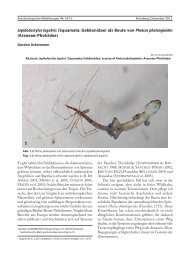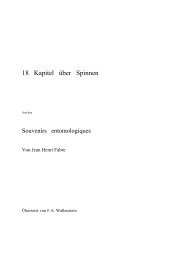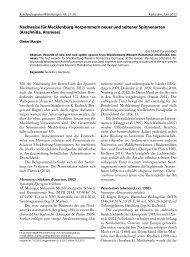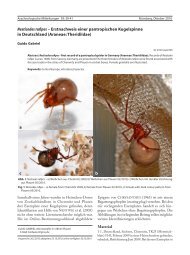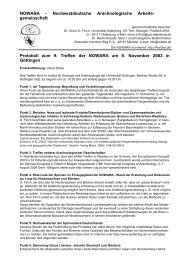A collection of spiders (Araneae) in Albanian coastal areas
A collection of spiders (Araneae) in Albanian coastal areas
A collection of spiders (Araneae) in Albanian coastal areas
Create successful ePaper yourself
Turn your PDF publications into a flip-book with our unique Google optimized e-Paper software.
Arachnologische Mitteilungen 44: 41-46 Nürnberg, Dezember 2012A <strong>collection</strong> <strong>of</strong> <strong>spiders</strong> (<strong>Araneae</strong>) <strong>in</strong> <strong>Albanian</strong> <strong>coastal</strong> <strong>areas</strong>Bler<strong>in</strong>a Vrenozidoi: 10.5431/aramit4407Abstract: The present study unites data from several excursions <strong>in</strong> typical Mediterranean lowland ecosystems <strong>in</strong> Albaniadur<strong>in</strong>g the years 2006 to 2009. Spiders from several different habitat types along the coast were analysed <strong>in</strong> six districts:Saranda, Fieri, Kavaja, Durrësi, Tirana and Lezha. In total 299 adult specimens were collected. They belong to 82 species,60 genera and 22 families. Six species are new to the <strong>Albanian</strong> fauna: Aculepeira armida (Audou<strong>in</strong>, 1826), Zygiella x-notata(Clerck, 1757), Histopona torpida (C. L. Koch, 1837), Malthonica campestris (C. L. Koch, 1834), Pellenes tripunctatus (Walckenaer, 1802)and Pseudeuophrys erratica (Walckenaer, 1826). With respect to zoogeography, the spider fauna is ma<strong>in</strong>ly characterized bythe presence <strong>of</strong> many Palaearctic species.Keywords: <strong>Albanian</strong> west lowland, faunistics, MediterraneanThe spider fauna <strong>of</strong> Albania rema<strong>in</strong>s <strong>in</strong>sufficientlystudied. The first reports were published by Simon(1884), Strand (1919), Caporiacco (1932, 1949),Giltay (1932), Drensky (1936), Schenkel (1947),Tongiorgi (1966) and Deeleman-Re<strong>in</strong>hold &Deeleman (1988). New and additional data can befound <strong>in</strong> the papers <strong>of</strong> Deltshev (1999), Blagoev(2005), Vrenozi & Haxhiu (2008), and Deltshevet al. (2011). Consider<strong>in</strong>g the variety <strong>of</strong> habitats –and compared to records from other Mediterraneancountries – many more spider species can be expectedto occur <strong>in</strong> Albania. The present study builds upon aseries <strong>of</strong> faunistic papers about the <strong>Albanian</strong> spiderfauna (Vrenozi & Haxhiu 2008, Deltshev et al.2011) and a zoogeographic analysis <strong>of</strong> the distribution<strong>of</strong> the recorded spider fauna from the <strong>coastal</strong> <strong>areas</strong> <strong>of</strong>Albania is presented.3. Durrësi – hill with P<strong>in</strong>us sp., 20 m a.s.l., N 41°13’56’’, E19°31’30’’, June 2008.4. Kavaja – mouth <strong>of</strong> river Shkumb<strong>in</strong>i with Phragmitesaustralis, Tamarix sp. and sandy dunes with Ech<strong>in</strong>ophorasp<strong>in</strong>osa, 0 m a.s.l., N 41°2’39’’, E 19°27’8’’, August 2007.5. Fieri – meadow, v<strong>in</strong>eyards and build<strong>in</strong>gs <strong>in</strong> Havaleasvillage, 0–15 m a.s.l., N 40°44’19’’, E 19°28’39’’, June–September 2007, April-May 2008.6. Saranda – hill with P<strong>in</strong>us sp. and bushes, stony coast withshrubs, build<strong>in</strong>gs, 0–200 m a.s.l., N 39°52’16’’, E 20°1’7’’,July 2007 (Fig. 1, Tab. 1).Materials and methodsField work was carried out between 2006 and 2009<strong>in</strong> six districts <strong>of</strong> Albania listed from north to south<strong>in</strong> the western lowlands (Fig. 1). Data on latitudeand longitude are taken from http://wikimapia.org :1. Lezha – sandy coast <strong>of</strong> Shëngj<strong>in</strong>i beach with P<strong>in</strong>us sp.,0 m a.s.l., N 41°46’55’’, E 19°36’10’’, June–August 2007.2. Tirana – Vora hill with Olea europaea, 144 m a.s.l., N41°23’12’’, E 19°39’23’’, June 2007, April-May 2008; BotanicGarden, hill with shrubs, 106 m a.s.l., N 41°18’37’’,E 19°48’20’’, June 2007; Dajti Mounta<strong>in</strong>, National Parkwith Fagus sylvatica, 1480 m, N 41°21’25’’, E 19°54’55’’,June 2007, June 2008.Bler<strong>in</strong>a VRENOZI, Universiteti i Tiranës, Fakulteti i ShkencaveNatyrore, Qendra Kërkimore e Florës dhe Faunës, Tirana –Albania; E-Mail: bler<strong>in</strong>a.vrenozi@fshn.edu.ale<strong>in</strong>gereicht: 9.4.2010, akzeptiert: 31.7.2012; onl<strong>in</strong>e verfügbar: 28.12.2012Fig. 1. Map <strong>of</strong> Albania with <strong>collection</strong> <strong>areas</strong>!
42 B. VrenoziVegetation, stones, rocks and ground, etc. were<strong>in</strong>vestigated for their spider content by hand collect<strong>in</strong>g,sweep<strong>in</strong>g with entomological nets and beat<strong>in</strong>g.Spiders were killed with ether or chlor<strong>of</strong>orm andpreserved <strong>in</strong> ethanol (75 %). The material is deposited<strong>in</strong> the Museum <strong>of</strong> Natural Sciences <strong>in</strong> Tirana.The primary literature used for identification<strong>in</strong>cluded Grimm (1985), Heimer & Nentwig(1991), Maurer (1992), Metzner (1999), Nentwiget al. (2011), Roberts (1987, 1995), andTürkes & Mergen (2008). In addition to thesecited references, specialist literature was used for identify<strong>in</strong>gsome similar species: Eresus kollari Rossi, 1846was dist<strong>in</strong>guished from Eresus moravicus Rezác, 2008follow<strong>in</strong>g Thaler & Kn<strong>of</strong>lach (2002) and Rezácet al. (2008); Alopecosa pulverulenta (Clerck, 1757) andTrochosa robusta (Simon, 1876) were identified us<strong>in</strong>gKronestedt (1990), Hepner & Milasowszky(2006) and Milasowszky et al. (1998) respectively.Comparative specimens <strong>of</strong> these latter species weresubsequently reviewed by the author <strong>in</strong> the SenckenbergNaturmuseum, Frankfurt am Ma<strong>in</strong> and <strong>in</strong> theInstitute <strong>of</strong> Zoology, S<strong>of</strong>ia.The order <strong>of</strong> families and nomenclature followsPlatnick (2011). Data concern<strong>in</strong>g the general distribution<strong>of</strong> <strong>spiders</strong> are taken from Platnick (2011)and Helsd<strong>in</strong>gen (2011).ResultsThe present study yielded 82 species belong<strong>in</strong>g to 60genera and 22 families (256 females, 43 males) (seeTab. 1). Six species are recorded here for the first timefrom Albania; five <strong>of</strong> which were collected only <strong>in</strong>Saranda, the southern district <strong>of</strong> Albania:Aculepeira armida (Audou<strong>in</strong>, 1826)This species is widely distributed <strong>in</strong> the southern parts<strong>of</strong> the Palaearctic. The female <strong>of</strong> A. armida can bedist<strong>in</strong>guished from A. ceropegia by the structure <strong>of</strong> theepigyne. Only one female was recorded <strong>in</strong> Saranda, 8.July 2007, <strong>in</strong> the Mirror beach, associated with rockyhabitats and shrubs.Zygiella x-notata (Clerck, 1757)Z. x-notata has a Holarctic distribution and is probablyalso present <strong>in</strong> the Neotropics. In Europe it issynanthropic, so an <strong>in</strong>troduction to other cont<strong>in</strong>entsseems to be “easy”. In Albania only one female was recorded<strong>in</strong> Saranda, 3. July 2007 on a hill with P<strong>in</strong>us sp.Histopona torpida (C. L. Koch, 1837)A Palaearctic species, widespread <strong>in</strong> Europe and Russia.H. torpida was checked aga<strong>in</strong>st H. italica and H.luxurians. In Albania three females were recorded <strong>in</strong>Saranda, 2. July 2007 on a hill with P<strong>in</strong>us sp.Malthonica campestris (C. L. Koch, 1834)This species has a Central and Eastern European distributionwith a few additional records <strong>in</strong> Azerbaijan.In Albania two females were recorded <strong>in</strong> Saranda, 7.July 2007 on the hill <strong>of</strong> Butr<strong>in</strong>ti castle, on the walls<strong>of</strong> the castle and adjacent bushes.Pellenes tripunctatus (Walckenaer, 1802)This species has a Palaearctic distribution. Threefemales were recorded, 2. June 2008, <strong>in</strong> the meadowsand forest with Fagus sylvatica <strong>of</strong> Dajti Mounta<strong>in</strong>,Tirana District.Pseudeuophrys erratica (Walckenaer, 1826)This is a Palaearctic species. The only female was recorded<strong>in</strong> Saranda, 7. July 2007, on the hill <strong>of</strong> Butr<strong>in</strong>ticastle, on walls and bushes.Accord<strong>in</strong>g to their currently known distribution theestablished 83 species can be classified <strong>in</strong>to sevenchorotypes (Taglianti et al. 1999), grouped <strong>in</strong>tothree chorological complexes: I, Cosmopolitan; II,Holarctic; III, European (Tab. 1 and 2).The Cosmopolitan species complex (COS, SCO)<strong>in</strong>cludes six species (7.3 %). The most frequentlyrecorded complex is the Holarctic one (HOL, OW,PAL, WPA, ECA) which comprises 68 species(82.9 %). The Palaearctic species (PAL, WPA, ECA)comprise 55 species (67.1 %), <strong>in</strong>habit<strong>in</strong>g both lowlandsand mounta<strong>in</strong>s, followed by Holarctic species(HOL) with 11 species (13.4 %). Only two Old Worldspecies were recorded, Argiope lobata (Pallas, 1772), sixfemales <strong>in</strong> the Saranda district, and Runc<strong>in</strong>ia grammica(C. L. Koch, 1837), one female at the mouth <strong>of</strong>the river Shkumb<strong>in</strong>i <strong>in</strong> the Kavaja district and tw<strong>of</strong>emales <strong>in</strong> the Tirana district. The European speciescomplex (EUR) species is also well represented andcomprises eight species (9.8 %).
Spiders along <strong>Albanian</strong> <strong>coastal</strong> <strong>areas</strong> 43Tab. 1: Species composition and distribution <strong>of</strong> the <strong>spiders</strong> found <strong>in</strong> the study <strong>areas</strong>(* new species for Albania; LE–Lezha, TR–Tirana, DR–Durrësi, KV–Kavaja, FR–Fieri, SR–Saranda. COS–Cosmopolitan; SCO–Subcosmopolitan; HOL–Holarctic; OW–Old World; PAL–Palaearctic; WPA–West-Palaearctic; ECA–European-Central Asian;EUR–European).List <strong>of</strong> Species LE TR DR KV FR SRZoogeographicaldistributionPholcidaePholcus phalangoides (Fuessl<strong>in</strong>, 1775) 7 3 5 COSSegestridaeSegestria senoculata (L<strong>in</strong>naeus, 1758) 1 PALDysderidaeDysdera crocata (C. L. Koch, 1838) 1 COSDysdera erythr<strong>in</strong>a (Walckenaer, 1802) 2 EUROonopidaeOonops domesticus Dalmas, 1916 1 EUREresidaeEresus kollari Rossi, 1846 3 ECATheridiidaeAsagena phalerata (Panzer, 1801) 1,2 PALSteatoda paykulliana (Walckenaer, 1805) 5 1 WPASteatoda triangulosa (Walckenaer, 1802) 1 COSL<strong>in</strong>yphiidaeAgnyphantes expunctus (O. P.-Cambridge, 1875) 3 1,2 PALBolyphantes luteolus (Blackwall, 1833) 2 PALFloronia bucculenta (Clerck, 1757) 1 EURFront<strong>in</strong>ell<strong>in</strong>a frutetorum (C. L. Koch, 1834) 5 1 PALLepthyphantes m<strong>in</strong>utus (Blackwall, 1833) 2 HOLL<strong>in</strong>yphia triangularis (Clerck, 1757) 5 PALPityohyphantes phrygianus (C. L. Koch, 1836) 5 3 2 PALTetragnathidaeTetragnatha extensa (L<strong>in</strong>naeus, 1758) 9 HOLTetragnatha nigrita Lendl, 1886 5 PALAraneidae*Aculepeira armida (Audou<strong>in</strong>, 1826) 1 PALAculepeira ceropegia (Walckenaer, 1802) 1 1 1 1 PALAgalenatea redii (Scopoli, 1763) 2 PALAraneus angulatus Clerck, 1757 4 6 PALAraneus diadematus Clerck, 1757 8 1 4 6 HOLAraneus quadratus Clerck, 1757 3 PALAraneus triguttatus (Fabricius, 1793) 1 PALArgiope bruennichi (Scopoli, 1772) 2 1 2 4 PALArgiope lobata (Pallas, 1772) 6 OWAraniella cucurbit<strong>in</strong>a (Clerck, 1757) 1 1 PALCyclosa conica (Pallas, 1772) 7 HOLCyclosa <strong>in</strong>sulana (Costa, 1834) 6 SCOCyclosa oculata (Walckenaer, 1802) 4 PALHypsos<strong>in</strong>ga heri (Hahn, 1831) 1 PALLar<strong>in</strong>ioides cornutus (Clerck, 1757) 3 1 5 2 HOLLar<strong>in</strong>ioides ixobulus (Thorell, 1873) 1 PALMangora acalypha (Walckenaer, 1802) 1 PAL*Zygiella x-notata Clerck, 1757 1 HOLLycosidaeAlopecosa pulverulenta (Clerck, 1757) 2 PALPardosa agricola (Thorell, 1856) 3 ECAPardosa pullata (Clerck, 1757) 1 ECATrochosa robusta (Simon, 1876) 1 PALTrochosa terricola Thorell, 1856 1,2 2 HOLPisauridaePisaura mirabilis (Clerck, 1757) 1 1 1 PAL
44 B. VrenoziList <strong>of</strong> Species LE TR DR KV FR SRZoogeographicaldistributionOxyopidaeOxyopes heterophthalmus Latreille, 1804 1 PALOxyopes l<strong>in</strong>eatus Latreille, 1806 1 PALAgelenidaeAgelena labyr<strong>in</strong>thica (Clerck, 1757) 3 PAL*Histopona torpida (C. L. Koch, 1843) 3 PAL*Malthonica campestris (C. L. Koch, 1834) 2 EURTegenaria domestica (Clerck, 1757) 1,3 4 COSTextrix denticulata (Olivier, 1789) 1 1 EURDictynidaeCicur<strong>in</strong>a cicur (Fabricius, 1793) 1 ECANigma puella (Simon, 1870) 1 EURTitanoecidaeTitanoeca quadriguttata (Hahn, 1833) 1 PALMiturgidaeCheiracanthium punctorium (Villers, 1789) 1 ECAClubionidaeClubiona brevipes Blackwall, 1841 1 PALClubiona caerulescens L. Koch, 1867 1 PALClubiona corticalis (Walckenaer, 1802) 2,6 ECAClubiona diversa O. P.-Cambridge, 1862 1 1,1 PALGnaphosidaeDrassodes cupreus (Blackwall, 1834) 2,4 EURDrassyllus praeficus (L. Koch, 1866) 1 ECAScotophaeus blackwalli (Thorell, 1871) 1 COSScotophaeus scutulatus (L. Koch, 1866) 1 WPASparassidaeMicrommata virescens (Clerck, 1757) 1,2 1 PALPhilodromidaeTibellus oblongus (Walckenaer, 1802) 1 HOLThomisidaeHeriaeus hirtus (Latreille, 1819) 2 EURMisumena vatia (Clerck, 1757) 1 HOLRunc<strong>in</strong>ia grammica (C. L. Koch, 1837) 2 1 OWSynema globosum (Fabricius, 1775) 4 PALSynema plorator (O. P.-Cambridge, 1872) 1 ECAThomisus onustus Walckenaer, 1805 2,10 1 1 1 PALXysticus cristatus (Clerck, 1757) 5,7 PALXysticus robustus (Hahn, 1832) 1 ECASalticidaeAelurillus v-<strong>in</strong>signitus (Clerck, 1757) 1 1 PALCarrhotus xanthogramma (Latreille, 1819) 1 PALEuophrys frontalis (Walckenaer, 1802) 4 PALEvarcha falcata (Clerck, 1757) 1 PALHeliophanus flavipes (Hahn, 1832) 1 PALHeliophanus tribulosus Simon, 1868 4 ECA*Pellenes tripunctatus (Walckenaer, 1802) 3 PALPhilaeus chrysops (Poda, 1761) 2 PAL*Pseudeuophrys erratica (Walckenaer, 1826) 1 PALSalticus scenicus (Clerck, 1757) 8 HOLSitticus pubescens (Fabricius, 1775) 1 HOLNumber <strong>of</strong> species 3 42 11 6 31 22Number <strong>of</strong> <strong>in</strong>dividuals 10 121 14 23 77 56
Spiders along <strong>Albanian</strong> <strong>coastal</strong> <strong>areas</strong> 45Tab. 2: Species number accord<strong>in</strong>g to complexes and chorotypes. Abbreviations as <strong>in</strong> Tab. 1.Complexes Chorotypes species number %COSCOS 5 6.1SCO 1 1.2Total 6 7.3HOL 11 13.4OW 2 2.4HOLPAL 43 52.4WPA 2 2.4ECA 10 12.2Total 68 82.9EUR EUR 8 9.8Total 8 9.8AcknowledgementsI express my s<strong>in</strong>cere appreciation to Pr<strong>of</strong>. Dr. Idriz Haxhiufor his support dur<strong>in</strong>g field work. I k<strong>in</strong>dly acknowledge theInstitute <strong>of</strong> Zoology <strong>in</strong> S<strong>of</strong>ia and the Senckenberg ResearchInstitute <strong>in</strong> Frankfurt am Ma<strong>in</strong> which provided laboratoryfacilities for review<strong>in</strong>g the spider material. I am grateful toDr. Peter Jäger and Dr. Christo Deltshev who confirmedthe identification <strong>of</strong> some species and helped to revise thispaper. I express my s<strong>in</strong>cere acknowledgements to Theo Blickand Dr. Ambros Hänggi, who gave important suggestions.The “ACE STUDY TOURS” <strong>of</strong>fered partial f<strong>in</strong>ancial supportto accomplish this work and to present the results atthe European Congress <strong>of</strong> Arachnology, Alexandroupolis,Greece 2009. The presentation <strong>of</strong> these results was alsopartly thanks to support from the ECA 2009.ReferencesBlagoev G. (2005): A contribution to the knowledge <strong>of</strong>the wolf <strong>spiders</strong> (<strong>Araneae</strong>: Lycosidae) <strong>of</strong> Albania. – ActaZoologica Bulgarica 57: 139-144Caporiacco L. di (1932): Aracnidi raccolti <strong>in</strong> Albaniadal dott. Pietro Parenzan. – Atti dell’Accademia Veneto-Trent<strong>in</strong>o-Istriana 23: 93-98Caporiacco L. di. (1949): Alcuni aracnidi albanesi. –Atti del Museo Civico di Storia Naturale di Trieste 17:122-125Deeleman-Re<strong>in</strong>hold C. & P.R. Deeleman (1988):Révision des Dysder<strong>in</strong>ae (<strong>Araneae</strong>, Dysderidae), lesespèces Méditerranéennes occidentales exceptées. –Tijdschrift voor Entomologie 131: 141-269Deltshev C. (1999): A faunistic and zoogeographicalreview <strong>of</strong> the <strong>spiders</strong> (<strong>Araneae</strong>) <strong>of</strong> the Balkan Pen<strong>in</strong>sula.– The Journal <strong>of</strong> Arachnology 27: 255-260Deltshev C., B. Vrenozi, G. Blagoev & S. Lazarov(2011): Spiders <strong>of</strong> Albania – faunistic and zoogeographicalreview (Arachnida, <strong>Araneae</strong>). – Acta ZoologicaBulgarica 63: 125-144Drensky P. (1936): Katalog der echten Sp<strong>in</strong>nen (<strong>Araneae</strong>)der Balkanhalb<strong>in</strong>sel. – Sbornik Bulgarska Akademia naNaukite 32: 1-223Giltay L. (1932): Arachnides récueillis par M. d’Orchymontau cours de ses voyages aux Balkans et en Asie M<strong>in</strong>eureen 1929, 1931 et 1932. – Bullet<strong>in</strong> du Musee d’Histoirenaturelle de Belgique 8 (22): 1-40Grimm U. (1985): Die Gnaphosidae Mitteleuropas (Arachnida,<strong>Araneae</strong>). – Abhandlungen des NaturwissenschaftlichenVere<strong>in</strong>s <strong>in</strong> Hamburg 26: 1-318Heimer S. & W. Nentwig (1991): Sp<strong>in</strong>nen Mitteleuropas:E<strong>in</strong> Bestimmungsbuch. Paul Parey, Berl<strong>in</strong>. 543 pp.Helsd<strong>in</strong>gen P.J. van (2011): <strong>Araneae</strong>. In: Fauna EuropaeaDatabase, version 1.2011. – Internet: http://www.european-arachnology.org/reports/fauna.shtml [accessedat 26 October 2011]Hepner M. & N. Milasowszky (2006): Morphologicalseparation <strong>of</strong> the central European Trochosa females(<strong>Araneae</strong>, Lycosidae). – Arachnologische Mitteilungen31: 1-7 – doi: 10.5431/aramit3101Kronestedt T. (1990): Separation <strong>of</strong> two species stand<strong>in</strong>gas Alopecosa aculeata (Clerck) by morphological, behaviouraland ecological characters, with remarks on relatedspecies <strong>in</strong> the pulverulenta group (<strong>Araneae</strong>, Lycosidae).– Zoologica Scripta 19: 203-225 – doi: 10.1111/j.1463-6409.1990.tb00256.xMetzner H. (1999): Die Spr<strong>in</strong>gsp<strong>in</strong>nen (<strong>Araneae</strong>, Salticidae)Griechenlands. – Andrias 14: 1-279Maurer R. (1992): Checkliste der europäischen Agelenidaenach der Roewerschen Systematik 1954 – unterBerücksichtigung angrenzender östlicher Gebiete, II.Holderbank (CH). 99 pp.Milasowszky N., M.E. Herberste<strong>in</strong> & K.P. Zulka.(1998): Morphological separation <strong>of</strong> Trochosa robusta(Simon, 1876) and Trochosa ruricola (De Geer, 1778)females (<strong>Araneae</strong>: Lycosidae). In: Selden P.A. (ed.):Proceed<strong>in</strong>gs <strong>of</strong> the 17th European Colloquium <strong>of</strong>Arachnology (Ed<strong>in</strong>burgh 1997): 91-96Nentwig W., T. Blick, D. Gloor, A. Hänggi & C.Kropf (2011): Spiders <strong>of</strong> Europe, version 6.2011. – Internet:www.araneae.unibe.ch [accessed at 26 October2011]
46 B. VrenoziPlatnick N.I. (2011): The world spider catalog, version11.0. American Museum <strong>of</strong> Natural History. – Internet:http://research.amnh.org/iz/<strong>spiders</strong>/catalog_11.0[accessed at 26 October 2011]Rezác M., S. Pekár & J. Johannesen (2008): Taxonomicreview and phylogenetic analysis <strong>of</strong> central EuropeanEresus species (<strong>Araneae</strong>: Eresidae). – Zoologica Scripta37: 263-287 – doi: 10.1111/j.1463-6409.2008.00328.xRoberts M.J. (1987): The <strong>spiders</strong> <strong>of</strong> Great Brita<strong>in</strong> andIreland, Volume 2: L<strong>in</strong>yphiidae and check list. HarleyBooks, Colchester. 204 pp.Roberts M.J. (1995): Coll<strong>in</strong>s Field Guide: Spiders <strong>of</strong>Brita<strong>in</strong> & Northern Europe. HarperColl<strong>in</strong>s, London.383 pp.Schenkel E. (1947): E<strong>in</strong>ige Mitteilungen über Sp<strong>in</strong>nentiere.– Revue suisse de Zoologie 54: 1-16Simon E. (1884): Etudes arachnologiques. 16e mémoire.23. Matériaux pour servir à la faune des Arachnides dela Grèce. – Annales de la Société entomologique deFrance 4(6): 305-356Strand E. (1919): Sp<strong>in</strong>nen und Opiliones aus Griechenland,Albanien und Kle<strong>in</strong>asien. – Archiv für Naturgeschichte82 A2: 158-167Taglianti A.V., P.A. Audisio, M. Biondi, M.A. Bologna,G.M. Carpaneto, A. De Biase, S. Fattor<strong>in</strong>i,E. Piattella, R. S<strong>in</strong>daco, A. Venchi & M. Zapparoli(1999): A proposal for a chorotype classification <strong>of</strong>the Near East fauna, <strong>in</strong> the framework <strong>of</strong> the WesternPalearctic region. – Biogeographia 20: 31-59Thaler K. & B. Kn<strong>of</strong>lach (2002): Zur Faunistik derSp<strong>in</strong>nen (<strong>Araneae</strong>) von Österreich: Atypidae, Haplogynae,Eresidae, Zodariidae, Mimetidae. – L<strong>in</strong>zerBiologische Beiträge 34: 413-444Tongiorgi P. (1966): Italian wolf <strong>spiders</strong> <strong>of</strong> the genusPardosa (<strong>Araneae</strong>: Lycosidae). – Bullet<strong>in</strong> <strong>of</strong> the Museum<strong>of</strong> Comparative Zoology 134: 275-334Türkes T. & O. Mergen (2008): The orb-web weavers<strong>spiders</strong> [sic] fauna <strong>of</strong> the central Anatolian region <strong>in</strong>Turkey with three new records for Turkey (<strong>Araneae</strong>,Araneidae). – Munis Entomology & Zoology 3: 295-302Vrenozi B. & I. Haxhiu (2008): [Data on order <strong>Araneae</strong>(Class Arachnida) <strong>in</strong> the Western Adriatic Lowland]. –Proceed<strong>in</strong>gs <strong>of</strong> International Conference on Biologicaland Environmental Sciences, 26–28 September 2008,Faculty <strong>of</strong> Natural Sciences, Tirana, Albania. Pp. 297-301 [<strong>in</strong> <strong>Albanian</strong>].


